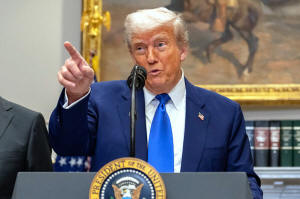|
The proposal, part of a budget reconciliation bill released
Monday, would advance President Donald Trump's agenda of
establishing “universal school choice” by providing families
nationwide the option to give their children an education
different from the one offered in their local public school.
Nearly all households would qualify except those making more
than three times the local median income.
Supporters of private school vouchers say they want to give
families assigned to low-performing schools more choices.
“Giving parents the ability to choose the best education for
their child makes the (American Dream) possible,” said
Republican Louisiana Sen. Bill Cassidy, who sponsored a similar
proposal in the Senate.
The program would be funded by donors who could contribute money
or stock. In turn, they would receive 100% of the contribution
back in the form of a discount on their tax bills. It would
allow stock holders to avoid paying taxes that would be levied
if they donated or transferred the stock.
Critics decried the proposal, saying it would aid the wealthy at
the expense of the public school systems that serve the
overwhelming majority of students. They said it would set up a
tax shelter allowing savvy investors to make money under the
guise of a donation.
All of this comes as the Trump administration downsizes the
Education Department and cuts resources to public schools,
including $1 billion in mental health grants and funding for
teacher training.
“This is a significant threat,” said Sasha Pudelski of AASA, the
School Superintendents Association. She added that states that
have voucher programs often end up assisting families that were
already paying for private school. “It’s opening the door even
wider to what has already plagued voucher programs around the
country, which is rampant waste, fraud, and abuse.”
Similar tax-credit scholarship and private school voucher
programs have proliferated in red-leaning states like Texas,
which just passed a $1 billion program. Public school advocates
worry the programs hurt enrollment and per-pupil funding,
ultimately leaving fewer resources for families that choose
public schools.
All contents © copyright 2025 Associated Press. All rights
reserved |
|




